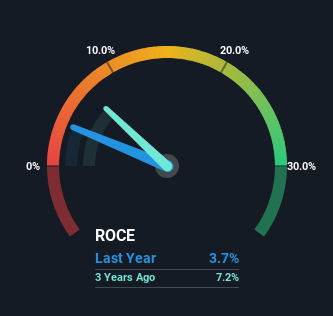- Germany
- /
- Consumer Durables
- /
- XTRA:TRU
Some Investors May Be Worried About Traumhaus' (ETR:TRU) Returns On Capital

What are the early trends we should look for to identify a stock that could multiply in value over the long term? Firstly, we'd want to identify a growing return on capital employed (ROCE) and then alongside that, an ever-increasing base of capital employed. Basically this means that a company has profitable initiatives that it can continue to reinvest in, which is a trait of a compounding machine. However, after investigating Traumhaus (ETR:TRU), we don't think it's current trends fit the mold of a multi-bagger.
What Is Return On Capital Employed (ROCE)?
If you haven't worked with ROCE before, it measures the 'return' (pre-tax profit) a company generates from capital employed in its business. To calculate this metric for Traumhaus, this is the formula:
Return on Capital Employed = Earnings Before Interest and Tax (EBIT) ÷ (Total Assets - Current Liabilities)
0.037 = €3.8m ÷ (€154m - €54m) (Based on the trailing twelve months to December 2022).
Therefore, Traumhaus has an ROCE of 3.7%. Ultimately, that's a low return and it under-performs the Consumer Durables industry average of 6.3%.
View our latest analysis for Traumhaus

Above you can see how the current ROCE for Traumhaus compares to its prior returns on capital, but there's only so much you can tell from the past. If you'd like to see what analysts are forecasting going forward, you should check out our free report for Traumhaus.
How Are Returns Trending?
On the surface, the trend of ROCE at Traumhaus doesn't inspire confidence. Around five years ago the returns on capital were 26%, but since then they've fallen to 3.7%. Given the business is employing more capital while revenue has slipped, this is a bit concerning. If this were to continue, you might be looking at a company that is trying to reinvest for growth but is actually losing market share since sales haven't increased.
On a side note, Traumhaus has done well to pay down its current liabilities to 35% of total assets. So we could link some of this to the decrease in ROCE. What's more, this can reduce some aspects of risk to the business because now the company's suppliers or short-term creditors are funding less of its operations. Some would claim this reduces the business' efficiency at generating ROCE since it is now funding more of the operations with its own money.
The Bottom Line On Traumhaus' ROCE
From the above analysis, we find it rather worrisome that returns on capital and sales for Traumhaus have fallen, meanwhile the business is employing more capital than it was five years ago. Unsurprisingly then, the stock has dived 80% over the last five years, so investors are recognizing these changes and don't like the company's prospects. Unless there is a shift to a more positive trajectory in these metrics, we would look elsewhere.
If you'd like to know more about Traumhaus, we've spotted 5 warning signs, and 2 of them are a bit concerning.
If you want to search for solid companies with great earnings, check out this free list of companies with good balance sheets and impressive returns on equity.
Valuation is complex, but we're here to simplify it.
Discover if Traumhaus might be undervalued or overvalued with our detailed analysis, featuring fair value estimates, potential risks, dividends, insider trades, and its financial condition.
Access Free AnalysisHave feedback on this article? Concerned about the content? Get in touch with us directly. Alternatively, email editorial-team (at) simplywallst.com.
This article by Simply Wall St is general in nature. We provide commentary based on historical data and analyst forecasts only using an unbiased methodology and our articles are not intended to be financial advice. It does not constitute a recommendation to buy or sell any stock, and does not take account of your objectives, or your financial situation. We aim to bring you long-term focused analysis driven by fundamental data. Note that our analysis may not factor in the latest price-sensitive company announcements or qualitative material. Simply Wall St has no position in any stocks mentioned.
About XTRA:TRU
Traumhaus
Engages in the purchase, development, marketing, and sale of real estate properties.
Undervalued with reasonable growth potential.
Market Insights
Community Narratives




